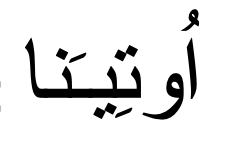| Introduction: Important Terms and Definitions about Long Vowels (Mad – مد) Let’s start asking some questions and answer them to internalize some of the fundamental terms and definitions about the topic of mad (elongation rules) in Quranic recitation before getting sophisticated. Q:🧐What is mad? A:🤓 Mad means elongation of a letter in different situations in the Qur’an. It either happens naturally or depending on some conditions. Q:🧐What is natural mad? A:🤓Natural mad is the elongation of a letter in the Qur’an because it is followed by one of the mad (elongation) letters that are visible or it is prolonged in its own nature without having a visible mad letter (being muqaddar or not written). Q:🧐What are mad letters and how many of them are there in the Qur’an? A:🤓There are 3 mad letters in Qur’an. These letters are (ا و ي ) without a short vowel (harakah). This sort of elongation is what we call Madd al-Tabee’ee (natural mad). Q:🧐What is natural mad? A:🤓If hamza or sukoon does not appear after a mad letter, due to its “nature”, the mad letter is prolonged only one note (or a second), this is referred to as Mad al-Aslee (The Natural, or The Original mad). Another name for it is Mad al-Tabee’ee. In a great example below, we see that three mad letters are followed by each other, resulting in Mad al-Tabee’ee (Natural) in the same word:
|
| Q:🧐What are other conditions causing elongation in Quranic recitation? A:🤓There are two other categories. Hamza ء and Sukoon ٥. Q:🧐What is Hamza ء and Sukoon ٥ ? A:🤓Hamza is an alif with short vowels/harakah: اَ ءَ Please note that ا without a short vowel/harakah can be in different forms such as a letter of mad or a letter of an article which will be studied later in upcoming sections. When it comes to Sukoon ٥, it is a letter without a short vowel/harakah. Q:🧐 Is there any other detail that I should know about Sukoon ٥? A:🤓 Definitely yes, there are some things you should know about it! Sukoon is divided into two categories: a. Permanent Sukoon: This type of sukoon is fixed and pronounced regardless if one stops or continues while reading a verse from the Qur’an, visible on the letters not only in the form sukoon but also shaddah ّ since each shaddah contains a sukoon. b. Temporary Sukoon: When one pauses or stops on a letter with harakah it becomes a sukoon and pronounced with sukoon. It only happens in stops at the end of ayat or when one pauses in the middle of ayat. Q:🧐How should I know or measure how much I would prolong in such mad conditions while reading Qur’an? And, What are the names of all elongation rules? A:🤓 This is exactly why you take these necessary steps to abide by the rule of recitation in order not to change the meaning of the Word of God (Qur’an) while reading it. Also, this is how we, Muslims, have orally transmitted Qur’an to the next generation for 1400 years since it was revealed to The Messenger of Allah, Muhammad (PBUH). In addition, here are the things you should know before getting into elongation rules in detail: We have 7 Major dialectics in pronouncing Qur’anic words which are called 7 Qira’at or 7 Ahruf. In Qira’at Al-Āsim (Rivayat Al-Hafs) that predominately read by Muslims in the World by 95%, there are 6 different kinds of elongation rules in Qur’anic recitation. These are vital rules that are not applied correctly may result in changing the meaning of the Words of God. These rules can be classified into two sections: mad al-Jáiz (optional) and mad al-Waajeeb (required) which will be abbreviated below as MJ and MW. These rules are classified according to the factors causing mad which will be defined below (i.e. Hamzah, Sukuun, etc.)
🤓Long story short, all things above are some essentials of mad rules. If any part of it does not make sense now, no worries! You can consult with your instructor at any time. If you don’t have one yet, you can reach me out at “[email protected]”🤓 Quick notes to remember☟______________________________________________ mad (elongation) Letters (ا و ي) The mad letters (Alif, Waaw,Yaa), are letters without harakah. The preceding letter should be 2 more seconds prolonged than usual. Madd Conditions (Requirements): There are instances in which mad needs extra prolongation. In short, this is referred to as the “elongation condition” and appears in two forms:
Simply, these conditions occur when one of mad letters ا و ي encounters with ٥ (Sukoon) or ء (Hamzah). When we formulate: (ا or و or ي) + (Sukoon) or (Hamzah) = generally 1-6 Alif elongation occurs. Each condition will be articulated in upcoming sections. Good Luck! 🤲 🤠 |
